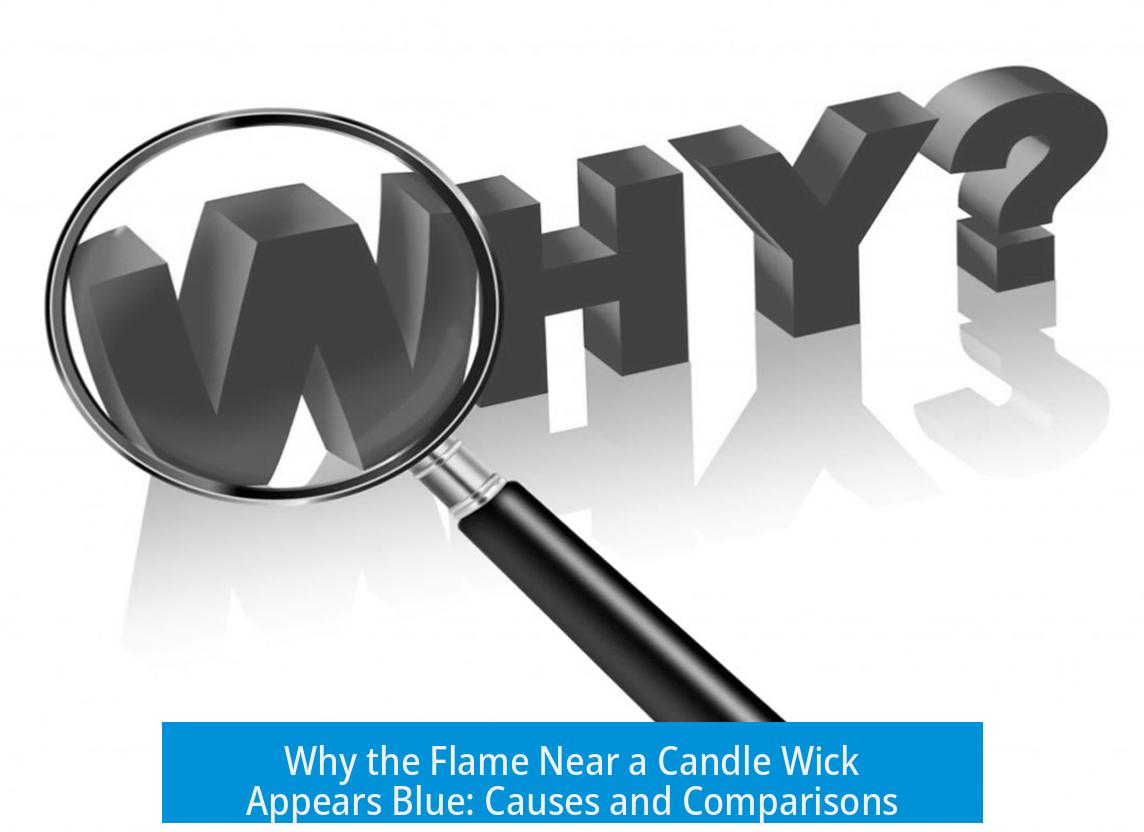Why Is the Flame Blue Closer to the Wick of a Candle?
The flame near a candle’s wick appears blue because this region contains no soot particles and features excited molecular species that emit blue light, due to more complete combustion supported by higher oxygen concentration. This contrasts with the yellow part of the flame, which results from glowing soot particles formed in regions of incomplete combustion.
Absence of Soot Near the Wick
The blue color near the wick arises because soot particles are absent in this part of the flame. Soot consists of tiny carbon particles created by incomplete combustion of hydrocarbons. These particles emit yellow light through black-body radiation, which gives most of the visible flame a yellow appearance.
Without soot particles near the wick, the black-body radiation that causes yellow light is missing, so the blue emission becomes visible. This lack of soot indicates a more complete combustion process close to the wick.
Emission from Excited Molecules and Radicals
The blue color is a result of light emitted by excited molecules and carbon radicals during combustion. As these excited species return to their ground state, they release photons in the blue region of the spectrum.
Carbon radicals form as hydrocarbons break down but have not yet bonded into soot particles. Near the wick, these radicals remain unreacted due to the combustion environment, allowing their characteristic blue emission to dominate.
Oxygen Availability Drives Combustion Completeness
Near the wick, oxygen is more abundant than in the upper flame regions. This high oxygen concentration facilitates complete combustion of hydrocarbon vapors from the melted wax.
- Complete combustion means carbon atoms fully react to form carbon dioxide and water; no excess carbon accumulates.
- Absence of partially oxidized species like carbon monoxide and free carbon radicals reduces yellow light-producing soot formation.
This more balanced combustion near the wick is the key reason the flame turns blue in this area.
Combustion Zones and Fuel Behavior in Candle Flames
The flame structure can be divided into zones:
- Lower Zone (near wick): Wax melts and vaporizes; vapor mixes with oxygen leading to more complete combustion.
- Upper Zone: Fuel-rich area where oxygen is limited, leading to incomplete combustion and soot formation.
The blue flame region aligns with the lower zone where fuel vapor and oxygen react efficiently, generating emission from excited radicals without soot interference.
The Role of Hydrocarbons and Combustion Balance
Candles consist of hydrocarbons with various chain lengths. The balanced combustion equation for a hydrocarbon can be written as:
CxHγ + (x + y/4) O2 → x CO2 + y/2 H2O
When the reaction is balanced, all carbon and hydrogen atoms convert fully to carbon dioxide and water. Any imbalance, particularly oxygen deficiency, causes leftover carbon atoms to agglomerate into soot.
Near the wick, adequate oxygen supply allows near-perfect balance, preventing soot formation and enabling blue light emission from molecular species.
The Interaction Between Soot and Flame Color
The faint blue glow present in the whole flame is usually masked by the bright yellow light produced by soot particles in the upper flame. Soot’s black-body radiation overwhelms other light emissions.
Where soot is absent near the wick, this blue emission dominates the flame’s color appearance. As soot forms higher in the flame, the yellow color dominates there.
Comparison with Gas Stove Flames
The same principles explain why gas stove flames appear blue. When sufficient oxygen mixes with fuel gas, soot formation is suppressed. Without soot, the flame emits primarily blue light from excited molecular species and radicals. The admitted oxygen ensures complete combustion.
Summary of Why the Flame Near the Wick Is Blue
- The blue flame results from emission lines of excited molecular species and carbon radicals in the lower flame.
- Soot particles, absent near the wick, produce yellow light through black-body radiation elsewhere in the flame.
- Higher oxygen availability near the wick enables more complete combustion, preventing soot formation.
- More complete combustion suppresses yellow soot glow and reveals the blue light emission.
- The blue glow comes before carbon radicals bond together into soot in upper flame zones.
- Candle wax vaporizes near the wick, creating a zone with balanced combustion conditions favoring blue light emission.
- The candle flame’s layered combustion zones dictate the color differences seen in the flame.




Leave a Comment